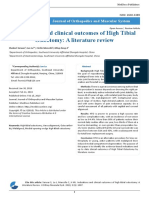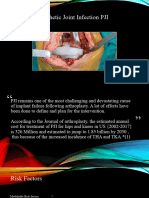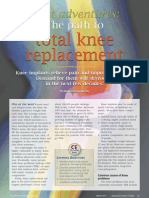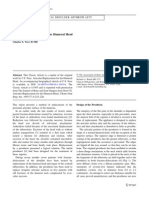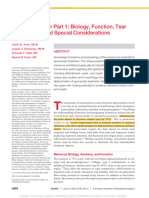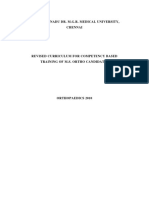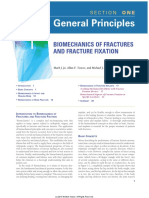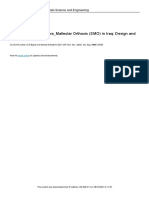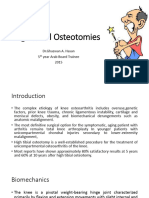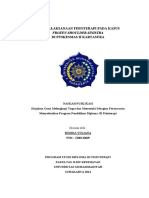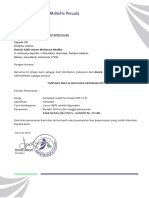100%(1)100% found this document useful (1 vote)
183 viewsUka Failure Mechanisms Vs TKR
Uka Failure Mechanisms Vs TKR
Uploaded by
api-267962692Copyright:
© All Rights Reserved
Available Formats
Download as PDF, TXT or read online from Scribd
Uka Failure Mechanisms Vs TKR
Uka Failure Mechanisms Vs TKR
Uploaded by
api-267962692100%(1)100% found this document useful (1 vote)
183 views7 pagesOriginal Title
uka failure mechanisms vs tkr
Copyright
© © All Rights Reserved
Available Formats
PDF, TXT or read online from Scribd
Share this document
Did you find this document useful?
Is this content inappropriate?
Copyright:
© All Rights Reserved
Available Formats
Download as PDF, TXT or read online from Scribd
Download as pdf or txt
100%(1)100% found this document useful (1 vote)
183 views7 pagesUka Failure Mechanisms Vs TKR
Uka Failure Mechanisms Vs TKR
Uploaded by
api-267962692Copyright:
© All Rights Reserved
Available Formats
Download as PDF, TXT or read online from Scribd
Download as pdf or txt
You are on page 1of 7
COPYRIGHT 2007 BY THE JOURNAL OF BONE AND JOINT SURGERY, INCORPORATED
Failure Mechanisms After Unicompartmental
and Tricompartmental Primary
Knee Replacement with Cement
By O. Furnes, MD, PhD, B. Espehaug, MSc, PhD, S.A. Lie, MSc, PhD,
S.E. Vollset, MD, DrPH, L.B. Engester, MD, PhD, and L.I. Havelin, MD, PhD
Investigation performed at Department of Orthopaedic Surgery, Haukeland University Hospital, Bergen, Norway
Background: Concern exists regarding the durability of unicompartmental knee replacements. The purpose of the
present study was to compare the early failure rates and failure mechanisms of primary cemented unicompartmental
knee replacements with those of primary cemented tricompartmental total knee replacements.
Methods: The rates of failure of primary cemented unicompartmental knee replacements (n = 2288) and tricompart-
mental total knee replacements (n = 3032) as reported to the Norwegian Arthroplasty Register from January 1994
through December 2004 were compared with use of Kaplan-Meier estimated survival rates and Cox multiple regression.
Results: The ten-year survival probability was 80.1% (95% confidence interval, 76.0% to 84.2%) for unicompartmen-
tal knee replacements, compared with 92.0% (95% confidence interval, 90.4 to 93.6%) for total knee replacements,
with a relative risk of revision of 2.0 (95% confidence interval, 1.6 to 2.5) (p < 0.001). This increased risk of revision
following unicompartmental knee replacement was seen in all age-categories. Unicompartmental knee replacement
was associated with an increased risk of revision due to pain (relative risk, 11.3 [95% confidence interval, 4.8 to
26.8]; p < 0.001), aseptic loosening of the tibial component (relative risk, 1.9 [95% confidence interval, 1.2 to 3.0];
p = 0.01) and of the femoral component (relative risk, 4.8 [95% confidence interval, 2.3 to 10.3]; p < 0.001), and
periprosthetic fracture (relative risk, 3.2 [95% confidence interval, 1.2 to 8.9]; p = 0.02) as compared with total knee
replacement. Unicompartmental knee replacement was associated with a lower risk of infection compared with total
knee replacement (relative risk, 0.28 [95% confidence interval, 0.10 to 0.74]; p = 0.01) .
Conclusions: The survival of cemented unicompartmental knee replacements is inferior to that of cemented tricom-
partmental total knee replacements in all age-categories.
Level of Evidence: Therapeutic Level II. See Instructions to Authors for a complete description of levels of evidence.
he Norwegian Orthopaedic Association started a na-
tional register for total hip replacement in 1987
1
. In
January 1994, the register was expanded to include all
artificial joint replacements, including those of the knee
2,3
.
One of the aims of the register is to detect inferior implants,
cements, and techniques as early as possible.
Unicompartmental knee replacements were popular in
the 1970s and 1980s in Europe, but, because of problems with
fixation and the high number of failures, the use of these im-
plants was reduced in the 1990s
4
. In the late 1990s, good ten-
year results of unicompartmental knee replacement were
reported from single centers in both the United States and
Britain
5,6
. These results, together with new instrumentation for
minimally invasive surgery, have renewed interest in this pro-
cedure, but there have been numerous reports of concern
about the durability of this type of prosthesis
7-10
.
The aim of the present study was to compare early fail-
ure rates and failure mechanisms of primary cemented uni-
compartmental knee replacements with those of primary
cemented tricompartmental total knee replacements with use
T
Disclosure: In support of their research for or preparation of this work, one or more of the authors received, in any one year, outside funding or
grants in excess of $10,000 from the Norwegian Medical Associations fund for Quality Improvement. Neither they nor a member of their immediate
families received payments or other benefits or a commitment or agreement to provide such benefits from a commercial entity. No commercial en-
tity paid or directed, or agreed to pay or direct, any benefits to any research fund, foundation, division, center, clinical practice, or other charitable or
nonprofit organization with which the authors, or a member of their immediate families, are affiliated or associated.
A commentary is available with the electronic versions of this article, on our web site (www.jbjs.org) and on our quarterly CD-ROM (call our subscription
department, at 781-449-9780, to order the CD-ROM).
Furnes.fm Page 519 Friday, February 9, 2007 2:32 PM
Downloaded From: http://jbjs.org/ by a SERIALS/BIOMED LIB 0699 User on 03/18/2014
THE JOURNAL OF BONE & JOI NT SURGERY J BJ S. ORG
VOLUME 89-A NUMBER 3 MARCH 2007
FAI LURE MECHANI SMS AFTER UNI COMPARTMENTAL AND
TRI COMPARTMENTAL PRI MARY KNEE REPLACEMENT WI TH CEMENT
of the nationwide prospective observational knee implant reg-
ister of all Norwegian hospitals.
Materials and Methods
fter each operation, a standard form is filled out by the sur-
geon and is sent to the register
11
. The reporting is similar to
that for hip replacement
1
. Stickers with catalogue numbers are
delivered by the manufacturers along with the implants and are
attached to the form by the operating surgeon. Femoral, tibial
baseplate, tibial polyethylene insert, and patellar components
are registered separately.
Information on revisions, defined as a surgical removal or
exchange of a part of the implant, or of the whole implant, was
linked to data on the primary operation with use of the unique
identification number assigned to each inhabitant of Norway.
The types of primary cemented unicompartmental
knee replacements used in Norway were the MOD III (Smith
and Nephew, Memphis, Tennessee), Genesis Uni (Smith and
Nephew), Oxford II and III (Biomet, Bridgend, South Wales,
United Kingdom), Duracon all-polyethylene tibial Uni (Stryker,
Berkshire, United Kingdom), Miller-Galante all-polyethylene
tibial Uni (Zimmer, Warsaw, Indiana), and Preservation (DePuy,
Leeds, United Kingdom) prostheses as well as other prostheses.
There were no uncemented unicompartmental knee replace-
ments. The size of the Preservation knee group and the other
group were too small for separate analyses.
The survival of cemented unicompartmental knee re-
placements and cemented patellar resurfaced total knee re-
placements, inserted in the period from January 1, 1994, to
December 31, 2004, was compared at five, seven, and ten years
of follow-up. For primary unicompartmental knee replace-
ments, we compared the time until revision for each brand of
prosthesis used. The five-year survival rates for the different
total knee replacement brands used in Norway were reported
in an earlier study
11
. The different causes of failure leading to
revision were compared for cemented unicompartmental
knee replacements and cemented total knee replacements. The
surgeon could report one or more causes of failure leading to
revision. Possible causes were aseptic loosening of the femoral,
tibial, or patellar component; dislocation or instability; mala-
lignment; deep infection; periprosthetic fracture; pain; wear of
a tibial insert; or other causes. To be classified as having a revi-
sion because of pain alone, no other reason for revision could
be marked. When seen in combination with any other cause,
infection was considered as the primary reason for revision.
The reports from the Norwegian Arthroplasty Register
were compared with the compulsory national hospital adminis-
trative database, the Norwegian Patient Register. An estimated
99% of the primary and 97% of the revision knee prostheses
were reported to the Norwegian Arthroplasty Register as com-
pared with the Norwegian Patient Register during the years
1999 through 2002
12
.
Statistical Analysis
Prosthesis survival was calculated with use of the Kaplan-Meier
method. Because of the low number of prostheses at risk after
eleven years of follow-up, survival results were estimated at ten
years, and for two of the prostheses with the shortest follow-up
(the Oxford III and the Miller-Galante prostheses), the results
were estimated at five years. The median duration of follow-up
was calculated with use of the reverse Kaplan-Meier method
13
.
The survival curves were stopped when the number of knees at
risk was lower than twenty. Patients who died or emigrated dur-
ing the follow-up period were identified from files provided by
Statistics Norway, and the follow-up time for prostheses in these
patients was censored at the date of death or emigration. A Cox
multiple regression model was used to study the relative risks of
revision among unicompartmental knee replacement prosthesis
brands, to study differences between unicompartmental knee
replacements and total knee replacements, and to adjust for po-
tential confounding by age (sixty years old or less, sixty-one to
sixty-nine years old, and seventy years old or more), gender,
and diagnosis (primary gonarthrosis, rheumatoid arthritis,
sequela after fracture, sequela after ligamentous instability, se-
quela after meniscal injury, and others). The confounding effect
of age was further investigated as a continuous variable within
age-categories. The average annual volume of surgery at indi-
vidual hospitals (zero to nine operations, ten to nineteen opera-
tions, and twenty to forty-nine operations) was tested in a Cox
model with adjustment for age, gender, and prosthesis design.
The statistical analyses were performed with use of SPSS
software (Advanced Statistics 13.0; SPSS, Chicago, Illinois)
and S-PLUS 2000 (Insightful, Seattle, Washington). Two-sided
p values of <0.05 were considered significant.
Results
Epidemiology of Knee Replacement Surgery
uring the study period, 19,669 primary knee replace-
ments were reported; of these, 3032 were cemented total
knee replacements with patellar resurfacing and 2288 were
A
D
TABLE I Patient Characteristics for Primary Cemented Unicompartmental and Tricompartmental Total Knee Prostheses as
Reported to the Norwegian Arthroplasty Register from 1994 to 2004
Type of Prosthesis
Number of
Prostheses Age (yr)
Proportion of Procedures
Performed in
Patients 60 Years Old
Proportion of
Procedures
Performed in Men
Tricompartmental total knee replacement* 3032 70 (17 to 92) 15% 26%
Unicompartmental knee replacement 2288 66 (25 to 91) 29% 38%
*Tricompartmental total knee replacements are total knee replacements performed with insertion of a patellar component (patellar resurfac-
ing). The values are given as the mean, with the range in parentheses.
Furnes.fm Page 520 Friday, February 9, 2007 2:32 PM
Downloaded From: http://jbjs.org/ by a SERIALS/BIOMED LIB 0699 User on 03/18/2014
THE JOURNAL OF BONE & JOI NT SURGERY J BJ S. ORG
VOLUME 89-A NUMBER 3 MARCH 2007
FAI LURE MECHANI SMS AFTER UNI COMPARTMENTAL AND
TRI COMPARTMENTAL PRI MARY KNEE REPLACEMENT WI TH CEMENT
unicompartmental knee replacements (Table I). The majority
of the rest of the replacements were cemented total knee re-
placements without patellar resurfacing. Unicompartmental
knee replacements accounted for 15% of the primary knee re-
placements in 2004 and 12% of the primary knee replace-
ments during the entire eleven-year study period. There was a
decrease in use from 1994 to 1998, with the lowest annual per-
centage of 5% in 1997, and then an increase in use. Ninety-
eight percent of the total knee replacements were posterior
cruciate-retaining designs
11
.
Patients managed with unicompartmental knee replace-
ment were younger and were more likely to be male in compari-
son with those managed with total knee arthroplasty (Table I).
In patients managed with unicompartmental knee replacement,
89% had primary osteoarthritis, 7.6% had sequelae after menis-
cal injury, 1.7% had sequelae of a fracture, 1.1% had sequelae of
osteochondritis, 1.4% had sequelae of osteonecrosis, 0.5% had
other diseases, and only 0.3% had rheumatoid arthritis.
A higher proportion of the Oxford III and Miller-
Galante prostheses were implanted in patients who were sixty
years old or less than was the case for prostheses that had
longer follow-up. An intact anterior cruciate ligament after
the operation was reported following 96% of the unicompart-
mental knee replacements (see Appendix). All of the uni-
compartmental knee replacements were cemented, with 89%
being cemented with use of Palacos cement with gentamicin
(Schering-Plough, Kenilworth, New Jersey). Only three types
of prostheses were meniscal-bearing: the Oxford II, the Ox-
ford III, and the Preservation. The Duracon and the Miller-
Galante unicompartmental knee replacements were always used
with an all-polyethylene tibial component, and the Genesis and
Preservation replacements were used with an all-polyethylene
tibial component in approximately one-quarter of the cases.
The most common polyethylene thicknesses for the tibial in-
sert were 8 and 10 mm, except for the Oxford II and III pros-
theses, for which 3.5, 4.5, and 5.5-mm-thick polyethylene
inserts were most common. The thinnest polyethylene com-
ponents (7.5 mm) for the MOD III implant were used at the
beginning of the period. It was not possible to determine
whether the prosthetic components were placed in the medial
or the lateral compartment in two of the prosthesis designs at
the beginning of the registration period because these two
implants could be used both in the lateral and the medial
compartment. The form was changed in 2001 to include regis-
tration of the lateral or medial compartment.
Volume of Surgery
The 2288 unicompartmental knee replacements had been per-
formed in fifty-one hospitals over an eleven-year period (see
Appendix). On the average, there had been four unicompart-
mental knee replacement operations per hospital per year
during the study period, and, at forty-three of the fifty-one
hospitals, there had been an average of fewer than ten proce-
dures per year. Seven types of unicompartmental knee re-
placements had been used in more than twenty knees each.
Four prostheses had been used in >100 knees. When we inves-
tigated all prostheses and all hospitals, we found that the hos-
pitals at which an average of twenty to forty-nine knee opera-
tions had been performed per year (n = 3) had a 40% lower
revision risk as compared with those at which zero to nine op-
erations had been performed per year (n = 43) (relative risk,
0.6 [95% confidence interval, 0.40 to 1.0]; p = 0.05). For the
Miller-Galante knee replacement, there was no hospital at
which an average of more than ten operations had been per-
formed per year, and therefore the influence of hospital sur-
gery volume could not be tested for this implant. For the
Oxford III knee replacement, there was no difference, with the
numbers available, between hospitals at which zero to nine (n =
30), ten to nineteen (n = 4), or twenty to forty-nine (n = 3)
procedures had been performed per year.
Survival Rates
The ten-year survival rate was 80.1% (95% confidence inter-
val, 76.0% to 84.2%) for unicompartmental knee replace-
ments and 92.0% (95% confidence interval, 90.4% to 93.6%)
for total knee replacements (Fig. 1 and Appendix). The rela-
tive risk of revision following unicompartmental knee replace-
ment as compared with total knee replacement was 2.0 (95%
confidence interval, 1.6 to 2.5; p < 0.001). The increased risk
of revision following unicompartmental knee replacement
Fig. 1
Kaplan-Meier survival curves for cemented tricompartmental total knee
replacements and cemented unicompartmental knee replacements.
Furnes.fm Page 521 Friday, February 9, 2007 2:32 PM
Downloaded From: http://jbjs.org/ by a SERIALS/BIOMED LIB 0699 User on 03/18/2014
THE JOURNAL OF BONE & JOI NT SURGERY J BJ S. ORG
VOLUME 89-A NUMBER 3 MARCH 2007
FAI LURE MECHANI SMS AFTER UNI COMPARTMENTAL AND
TRI COMPARTMENTAL PRI MARY KNEE REPLACEMENT WI TH CEMENT
was seen in all age-categories (see Appendix).
Compared with total knee replacement, unicompartmen-
tal knee replacement was associated with more revisions be-
cause of pain (relative risk, 11.3 [95% confidence interval, 4.8 to
26.8]; p < 0.001), aseptic loosening of the tibial component (rel-
ative risk, 1.9 [95% confidence interval, 1.2 to 3.0]; p = 0.01)
and of the femoral component (relative risk, 4.8 [95% confi-
dence interval, 2.3 to 10.3]; p < 0.001), and periprosthetic frac-
ture (relative risk, 3.2 [95% confidence interval, 1.2 to 8.9]; p =
0.02). There was, however, a decreased risk of revision because
of infection following unicompartmental knee replacement as
compared with total knee replacement (relative risk, 0.28 [95%
confidence interval, 0.10 to 0.74]; p = 0.01) (Table II).
After ten years of follow-up, there was no significant
difference in survival among the MOD III, Genesis Uni, and
Oxford II knee replacements, with the numbers available.
However, although the number of Duracon prostheses was
low (n = 47), Duracon knee replacements were associated
with a significantly higher risk of revision as compared with
the other unicompartmental knee replacements (relative risk
at five years, 3.0 [95% confidence interval, 1.3 to 6.8]; p = 0.01)
(Fig. 2-A and Appendix). After five years, the Miller-Galante
knee prosthesis (survival rate, 83.0%; 95% confidence inter-
val, 76.3% to 89.7%) had a significantly higher rate of revision
than the Oxford III knee prosthesis (survival rate, 91.1%; 95%
confidence interval, 88.7% to 93.5%) (relative risk of revision,
1.8 [95% confidence interval, 1.1 to 2.8]; p = 0.01) (Fig. 2-B
and Appendix). The results for the prostheses used primarily
over the last five years were not better than those for the pros-
theses used mainly the first five years of registration, with the
numbers available (see Appendix). The higher failure rates of
the Duracon and Miller-Galante knees were mainly due to
more loosening of the tibial component. For the MOD III
prosthesis, there were significantly more revisions in associa-
tion with the 7.5-mm tibial components as compared with the
9-mm components (relative risk, 3.5 [95% confidence inter-
val, 1.3 to 9.1]; p = 0.009). For the Genesis prosthesis, there
were also more revisions for the 8-mm tibial inserts as com-
pared with the 10 and 12-mm inserts (relative risk, 6.2 [95%
confidence interval, 1.3 to 28.8]; p = 0.02).
Two hospitals were found to have <60% survival of the
Miller-Galante knee prosthesis after five years, while other hospi-
tals had 100% survival after five years (p = 0.001 [see Appendix]).
Few lateral unicompartmental knee arthroplasties were
performed. For the Genesis knee replacement, which was in-
serted in the lateral compartment 12% of the time, we found
no difference in survival between lateral and medial compart-
ment prostheses with the numbers available (relative risk, 0.53
[95% confidence interval, 0.12 to 2.29]).
Discussion
he major finding of the present study was that the rate of
revision following unicompartmental knee replacement
was twice as high as that following total knee replacement as a
result of higher rates of revision due to femoral and tibial
loosening, periprosthetic fracture, and pain. The increased
risk of revision following unicompartmental knee replace-
ment was seen in all age-categories and had not improved
during the last five-year period as compared with the earlier
period. The finding confirms those of other register studies
14,15
but not those of studies from specialized centers
5,6,16
.
The volume of surgery mattered, with the risk of revi-
sion being 40% lower in hospitals at which twenty to forty-
nine operations were performed per year as compared with
hospitals at which zero to nine operations were performed per
year. This finding corresponds well with those of registry stud-
ies on hip replacement
17,18
. For the Oxford III knee replace-
ment, there was no difference in the risk of revision between
low and high-volume hospitals, but the duration of follow-up
was short and the number of hospitals with high numbers of
procedures was low. Our findings for the Oxford III knee re-
placement are in accordance with those of more recent results
from the Australian registry
19
but contradict the findings from
the Swedish registry
20
on the earlier Oxford phase-II knee re-
placement, in which the results were better in hospitals with
more than twenty-three procedures per hospital per year. This
might be explained by better education of surgeons and better
instrumentation in association with Oxford III knees as com-
T
TABLE II Reasons for Revision of Cemented Unicompartmental Knee Replacements and Cemented Tricompartmental
Total Knee Replacements as Reported to the Norwegian Arthroplasty Register from 1994 to 2004
Type of Prosthesis
Loose Femoral
Component
Loose Tibial
Component
Loose Patellar
Component
Tricompartmental total knee replacement (n = 3032) 11 41 9
Unicompartmental knee replacement (n = 2288) 38 44 0
Relative risk of revision* 4.8 (2.3 to 10.3) 1.9 (1.2 to 3.0) No estimate
P value <0.001 0.01
*The Cox relative risk of revision, with the 95% confidence interval in parentheses, is given for unicompartmental knee replacement as com-
pared with total knee replacement. Regression analyses were adjusted for age (sixty years or less, sixty-one to sixty-nine years, seventy
years or more), gender, diagnosis, and type of prosthesis. The Cox estimates were based on replacements in which systemic antibiotics were
given and prostheses were cemented with Palacos, with or without gentamicin. Posterior stabilized and constrained prostheses were ex-
cluded from the comparison.
Furnes.fm Page 522 Friday, February 9, 2007 2:32 PM
Downloaded From: http://jbjs.org/ by a SERIALS/BIOMED LIB 0699 User on 03/18/2014
THE JOURNAL OF BONE & JOI NT SURGERY J BJ S. ORG
VOLUME 89-A NUMBER 3 MARCH 2007
FAI LURE MECHANI SMS AFTER UNI COMPARTMENTAL AND
TRI COMPARTMENTAL PRI MARY KNEE REPLACEMENT WI TH CEMENT
pared with Oxford II knees. In the present study, we were not
able to control for the volume of operations per surgeon, and
this might have confounded our results.
Several studies have indicated that unicompartmental
knee replacement is associated with less pain and better function
in comparison with total knee replacement
21,22
. In a randomized,
controlled study in which the St. Georg Sled unicompartmental
knee replacement was compared with the Kinematic total knee
replacement with a patellar component, the authors found bet-
ter function and less morbidity in association with the unicom-
partmental knee replacement after five years and reported the
same survival for the two prostheses on the basis of the num-
bers available
23
. These results persisted for as long as ten years
24
and contradict the findings of our study. Our study was an ob-
servational one, and the patients who were selected for unicom-
partmental knee replacement could have been more active and
healthier and therefore could have put the prostheses under
more stress, leading to more loosening. A few dedicated sur-
TABLE II (continued)
Infection
Instability/
Dislocation Periprosthetic Fracture
Pain
Alone
Wear of
Tibial Insert
Other
Causes
37 40 9 7 22 16
5 21 11 48 19 18
0.28 (0.10 to 0.74) 0.96 (0.53 to 1.7) 3.2 (1.2 to 8.9) 11.3 (4.8 to 26.8) 1.8 (0.92 to 3.6) 2.0 (0.96 to 4.3)
0.01 0.9 0.02 <0.001 0.09 0.06
Fig. 2-A
Figs. 2-A and 2-B Kaplan-Meier survival curves for unicompartmental knee replacements according to the duration of follow-up.
Fig. 2-B
Furnes.fm Page 523 Friday, February 9, 2007 2:32 PM
Downloaded From: http://jbjs.org/ by a SERIALS/BIOMED LIB 0699 User on 03/18/2014
THE JOURNAL OF BONE & JOI NT SURGERY J BJ S. ORG
VOLUME 89-A NUMBER 3 MARCH 2007
FAI LURE MECHANI SMS AFTER UNI COMPARTMENTAL AND
TRI COMPARTMENTAL PRI MARY KNEE REPLACEMENT WI TH CEMENT
geons participating in a randomized study might also have per-
formed the more technically demanding unicompartmental
knee replacements better than surgeons across an entire country.
As we do not have information on the degree of pain
and functional scores of the patients, we cannot conclude
whether the patients in the unicompartmental knee replace-
ment group actually had more pain than did those in the total
knee replacement group or whether the revision operation
helped. Only two of the revisions following unicompartmen-
tal knee replacement in our study were reported as being due
to progression of arthritis. Progression of arthritis has been re-
garded a major cause of revision in earlier studies
7,15,16,25
. Our
findings are supported by the study of St. Georg Sled unicom-
partmental knee replacements, in which none of the knees
progressed to arthrosis
23
, and also by the study by Berger et al.,
in which only one of sixty-one knees progressed
5
. Our find-
ings could have been due to better patient selection or to a reg-
istration bias related to the fact that progression of arthritis is
not part of the eleven standard reasons for revision on the reg-
istration form and therefore the surgeons must mark the rea-
son for revision as other and specify progression of arthritis.
Thus, some surgeons could have wrongly marked pain even
though the reason was progression of arthritis.
The lower infection rate following the unicompartmen-
tal knee replacements confirms the early results from the
Swedish Knee Arthroplasty Register
26
.
The Duracon prosthesis had inferior survival results
than did the other designs. The results must be interpreted
with caution as the implant had been used in a small number
of patients and at only five hospitals. The Duracon prosthesis
was associated with inferior results in another study
27
. The au-
thors concluded that the reason for the poor results was due to
the use of polyethylene that had been gamma-sterilized in air
and had a shelf life of over four years.
The Miller-Galante implant with an all-polyethylene
tibial component had a five-year survival rate of 83% in our
study, which was significantly inferior to the 91% survival rate
for the Oxford III prosthesis. Berger et al. reported a ten-year
survival rate of 98% for the Miller-Galante prosthesis
5
, and
Naudie et al. reported a ten-year survival rate of 90% for that
prosthesis
28
. In both of those studies, a metal-backed tibial
component was used, whereas in Norway an all-polyethylene
tibial component was used. In a previous two-year study of
Miller-Galante unicompartmental knee replacements, the re-
sults of procedures performed with an all-polyethylene tibial
component were similar to those of procedures performed
with a metal-backed tibial component
29
, contradicting the
findings of our study. In the last yearly report from the Swed-
ish knee register, the Miller-Galante unicompartmental knee
replacement was reported to be associated with a higher risk
for revision than the Link unicompartmental knee replace-
ment, but, because metal and all-polyethylene tibial compo-
nents were analyzed together, no conclusion regarding the
issue of the use of all-polyethylene tibial components can be
drawn on the basis of that report
14
. In a report from Australia,
the Miller-Galante unicompartmental knee replacement was
associated with good short-term results, but the report did not
specify whether an all-polyethylene or a metal-backed tibial
component had been used
19
. Our finding of poor performance
due to the aseptic loosening of the tibial components of the
Duracon and Miller-Galante prostheses questions the concept
of using an all-polyethylene tibial component for unicompart-
mental knee replacement.
As we did not register whether minimally invasive tech-
niques were used at the time of surgery, their influence on the
individual prosthesis could not be resolved. However, we did
conduct a postal survey that was sent to all Norwegian operat-
ing clinics in September 2003 in which we inquired about the
use of minimally invasive techniques for unicompartmental
knee replacement. The results were analyzed according to the
year of surgery (beginning in 1994) and prosthesis design. The
Oxford III and the Miller-Galante prostheses were inserted
with a minimally invasive technique in 98% and 90% of cases,
respectively, and it is thus unlikely that the use of minimally
invasive techniques explains the difference in performance be-
tween these two prostheses.
Loosening was most commonly seen in association with
tibial components with thin polyethylene, which is in accor-
dance with the findings of other studies
30
.
There was no difference in survival between lateral and
medial prostheses in cases in which the Genesis unicompart-
mental prosthesis had been used, which is in accordance with
the results of the Swedish knee register
25,31
.
It has been recommended that a unicompartmental pros-
thesis should be suitable for 20% to 30% of knee replacement
procedures
6,32
, but some authors have disputed this great per-
centage
33
. The fact that the Oxford knee has been the most used
unicompartmental knee replacement in Norway in recent years
probably explains the growing popularity of unicompartmen-
tal knee replacement, from 5% of the total number of primary
knee replacements in 1997 to 15% in 2004. This rate is compa-
rable with the percentages from Sweden and Australia
14,19
. Our
data were used in a decision-analysis study that showed that
unicompartmental knee replacement can be cost effective as
compared with total knee replacement in patients older than
seventy years of age
34
.
The procedure of unicompartmental knee replacement,
especially that involving minimally invasive techniques, has
been reported to result in less morbidity in the form of pain,
faster recovery, shorter hospitalization, less infection, less
thromboembolic disease, and better range of movement
23,35,36
as compared with total knee replacement. The present study
demonstrates that these short-term advantages must be
weighed against higher revision rates due to aseptic loosening
of the tibial and femoral components, persistent pain, and
periprosthetic fractures.
Appendix
Additional tables and figures showing the data broken
down by prosthesis type, patient age, and hospital are
available with the electronic versions of this article, on our
web site at jbjs.org (go to the article citation and click on
Furnes.fm Page 524 Friday, February 9, 2007 2:32 PM
Downloaded From: http://jbjs.org/ by a SERIALS/BIOMED LIB 0699 User on 03/18/2014
THE JOURNAL OF BONE & JOI NT SURGERY J BJ S. ORG
VOLUME 89-A NUMBER 3 MARCH 2007
FAI LURE MECHANI SMS AFTER UNI COMPARTMENTAL AND
TRI COMPARTMENTAL PRI MARY KNEE REPLACEMENT WI TH CEMENT
Supplementary Material) and on our quarterly CD-ROM
(call our subscription department, at 781-449-9780, to order
the CD-ROM).
NOTE: The authors are grateful to the Norwegian orthopaedic surgeons who reported their
cases to the register.
O. Furnes, MD, PhD
B. Espehaug, MSc, PhD
S.A. Lie, MSc, PhD
Department of Orthopaedic Surgery, Haukeland University Hospital, N-5021
Bergen, Norway. E-mail address for O. Furnes: ove.furnes@haukeland.no
L.B. Engester, MD, PhD
L.I. Havelin, MD, PhD
Department of Surgical Sciences, University of Bergen, N-5021 Bergen,
Norway
S.E. Vollset, MD, DrPH
Section for Epidemiology and Medical Statistics, Department of Public
Health and Primary Health Care, University of Bergen, P.O. Box 7804,
N-5020 Bergen, Norway
doi:10.2106/JBJS.F.00210
References
1. Havelin LI. The Norwegian Joint Registry. Bull Hosp Jt Dis. 1999;58:139-47.
2. Furnes A, Havelin LI, Engesaeter LB, Lie SA. [Quality control of prosthetic
replacements of knee, ankle, toe, shoulder, elbow and finger joints in Norway
1994. A report after the first year of registration of joint prostheses in the na-
tional registry]. Tidsskr Nor Laegeforen. 1996;116:1777-81. Norwegian.
3. Havelin LI, Engesaeter LB, Espehaug B, Furnes O, Lie SA, Vollset SE. The
Norwegian Arthroplasty Register: 11 years and 73,000 arthroplasties. Acta
Orthop Scand. 2000;71:337-53.
4. Lidgren L, Knutson K, Robertsson O. Annual Report 2004The Swedish Knee
Arthroplasty Register. www.ort.lu.se/knee. Accessed 2007 Jan 7.
5. Berger RA, Nedeff DD, Barden RM, Sheinkop MM, Jacobs JJ, Rosenberg
AG, Galante JO. Unicompartmental knee arthroplasty. Clinical experience at
6- to 10-year followup. Clin Orthop Relat Res. 1999;367:50-60.
6. Murray DW, Goodfellow JW, OConnor JJ. The Oxford medial unicompartmental
arthroplasty: a ten-year survival study. J Bone Joint Surg Br. 1998;80:983-9.
7. Insall J, Aglietti P. A five to seven-year follow-up of unicondylar arthroplasty.
J Bone Joint Surg Am. 1980;62:1329-37.
8. Insall J, Walker P. Unicondylar knee replacement. Clin Orthop Relat Res.
1976;120:83-5.
9. Laskin RS. Unicompartmental tibiofemoral resurfacing arthroplasty. J Bone
Joint Surg Am. 1978;60:182-5.
10. Rand JA, Ilstrup DM. Survivorship analysis of total knee arthroplasty.
Cumulative rates of survival of 9200 total knee arthroplasties. J Bone Joint
Surg Am.1991;73:397-409.
11. Furnes O, Espehaug B, Lie SA, Vollset SE, Engesaeter LB, Havelin LI. Early
failures among 7,174 primary total knee replacements: a follow-up study from
the Norwegian Arthroplasty Register 1994-2000. Acta Orthop Scand. 2002;
73:117-29.
12. Espehaug B, Furnes O, Havelin LI, Engester LB, Vollset SE, Kindseth O.
Registration completeness in the Norwegian Arthroplasty Register. Acta Orthop.
2006;77:49-56.
13. Schemper M, Smith TL. A note on quantifying follow-up in studies of failure
time. Control Clin Trials. 1996;17:343-6.
14. Lidgren L, Knutson K, Robertsson O. Annual Report 2005The Swedish
Knee Arthroplasty Register www.knee.nko.se. Accessed 2007Jan 7.
15. Gioe TJ, Killeen KK, Hoeffel DP, Bert JM, Comfort TK, Scheltema K, Mehle S,
Grimm K. Analysis of unicompartmental knee arthroplasty in a community-based
implant registry. Clin Orthop Relat Res. 2003;416:111-9.
16. Price AJ, Dodd CA, Svard UG, Murray DW. Oxford medial unicompartmental
knee arthroplasty in patients younger and older than 60 years of age. J Bone
Joint Surg Br. 2005;87:1488-92.
17. Espehaug B, Havelin LI, Engesaeter LB, Vollset SE. The effect of hospital-type
and operating volume on the survival of hip replacements. A review of 39,505
primary total hip replacements reported to the Norwegian Arthroplasty Register,
1988-1996. Acta Orthop Scand. 1999;70:12-8.
18. Losina E, Barrett J, Mahomed NN, Baron JA, Katz JN. Early failures of total
hip replacement: effect of surgeon volume. Arthritis Rheum. 2004;50:1338-43.
19. Graves S, Davidson D, Ingerson L, Ryan P, Griffith L, McDermott B, Pratt N.
Australian Orthopaedic Association National Joint Replacement Registry Annual
Report 2005. www.dmac.adelaide.edu.au/aoanjrr. Accessed 2007 Jan 7.
20. Robertsson O, Knutson K, Lewold S, Lidgren L. The routine of surgical man-
agement reduces failure after unicompartmental knee arthroplasty. J Bone Joint
Surg Br. 2001;83:45-9.
21. Laurencin CT, Zelicof SB, Scott RD, Ewald FC. Unicompartmental versus total
knee arthroplasty in the same patient. A comparative study. Clin Orthop Relat
Res. 1991;273:151-6.
22. Rougraff BT, Heck DA, Gibson AE. A comparison of tricompartmental and uni-
compartmental arthroplasty for the treatment of gonarthrosis. Clin Orthop Relat
Res. 1991;273:157-64.
23. Newman JH, Ackroyd CE, Shah NA. Unicompartmental or total knee re-
placement? Five-year results of a prospective, randomised trial of 102 os-
teoarthritic knees with unicompartmental arthritis. J Bone Joint Surg Br.
1998;80:862-5.
24. Ackroyd CE, Whitehouse SL, Newman JH, Joslin CC. A comparative study of
the medial St Georg Sled and Kinematic total knee arthroplasties. Ten-year survi-
vorship. J Bone Joint Surg Br. 2002;84:667-72.
25. Knutson K, Lewold S, Robertsson O, Lidgren L. The Swedish knee arthro-
plasty register. A nation-wide study of 30,003 knees 1976-1992. Acta Orthop
Scand. 1994;65:375-86.
26. Bengtson S, Knutson K. The infected knee arthroplasty. A 6-year follow-up of
357 cases. Acta Orthop Scand. 1991;62:301-11.
27. McGovern TF, Ammeen DJ, Collier JP, Currier BH, Engh GA. Rapid polyethylene
failure of unicondylar tibial components sterilized with gamma irradiation in air
and implanted after a long shelf life. J Bone Joint Surg Am. 2002;84:901-6.
28. Naudie D, Guerin J, Parker DA, Bourne RB, Rorabeck CH. Medial unicompart-
mental knee arthroplasty with the Miller-Galante prosthesis. J Bone Joint Surg
Am. 2004;86:1931-5.
29. Hyldahl HC, Regner L, Carlsson L, Karrholm J, Weidenhielm L. Does metal
backing improve fixation of tibial component in unicondylar knee arthroplasty?
A randomized radiostereometric analysis. J Arthroplasty. 2001;16:174-9.
30. Knutson K, Jonsson G, Langer Andersen J, Larusdottir H, Lidgren L. Deforma-
tion and loosening of the tibial component in knee arthroplasty with unicompart-
mental endoprostheses. Acta Orthop Scand. 1981;52:667-73.
31. Knutson K, Lindstrand A, Lidgren L. Survival of knee arthroplasties. A
nation-wide multicentre investigation of 8000 cases. J Bone Joint Surg Br.
1986;68:795-803.
32. Lindstrand A. Surgery for unicompartmental osteoarthritis of the knee. Euro-
pean Instr Course Lect. 1999;4:105-11.
33. Ritter MA, Faris PM, Thong AE, Davis KE, Meding JB, Berend ME. Intra-
operative findings in varus osteoarthritis of the knee. An analysis of pre-
operative alignment in potential candidates for unicompartmental arthroplasty.
J Bone Joint Surg Br. 2004;86:43-7.
34. Slover J, Espehaug B, Havelin LI, Engesaeter LB, Furnes O, Tomek I, Tosteson
A. Cost-effectiveness of unicompartmental and total knee arthroplasty in elderly
low-demand patients. A Markov decision analysis. J Bone Joint Surg Am. 2006;
88:2348-55.
35. Lewold S. The Swedish knee arthroplasty study with special reference
to unicompartmental prostheses [PhD thesis]. Lund, Sweden: Lund Univer-
sity; 1997.
36. Robertsson O. The Swedish Knee Arthroplasty Register. Validity and outcome
[PhD thesis]. Lund, Sweden: Lund University; 2000.
Furnes.fm Page 525 Friday, February 9, 2007 2:32 PM
Downloaded From: http://jbjs.org/ by a SERIALS/BIOMED LIB 0699 User on 03/18/2014
You might also like
- AOTrauma Periprosthetic Fracture Management Thieme 2014Document402 pagesAOTrauma Periprosthetic Fracture Management Thieme 2014Marly OrtopediaNo ratings yet
- Arthrex Shoulder Repair TehnologyDocument26 pagesArthrex Shoulder Repair TehnologyNicusor Anghel100% (1)
- Indications and Clinical Outcomes of High Tibial Osteotomy A Literature ReviewDocument8 pagesIndications and Clinical Outcomes of High Tibial Osteotomy A Literature ReviewPaul HartingNo ratings yet
- Exeter Hip PDFDocument2 pagesExeter Hip PDFTravis25% (4)
- Genu ValgoDocument9 pagesGenu Valgoazulqaidah95No ratings yet
- PJIsDocument29 pagesPJIsMohammed Alfahal100% (2)
- Total Knee Replacement: The Path ToDocument6 pagesTotal Knee Replacement: The Path ToMoses DhinakarNo ratings yet
- Total Knee Arthroplasty For Severe Valgus Deformity: J Bone Joint Surg AmDocument15 pagesTotal Knee Arthroplasty For Severe Valgus Deformity: J Bone Joint Surg AmAbdiel NgNo ratings yet
- Shoulder Arthroplasty Neer 1955Document13 pagesShoulder Arthroplasty Neer 1955Jorge LourençoNo ratings yet
- A Systematic Approach To The Hip-Spine Relationship and Its Applications To Total Hip Arthroplasty - Eftekhary Et Al. 2019Document9 pagesA Systematic Approach To The Hip-Spine Relationship and Its Applications To Total Hip Arthroplasty - Eftekhary Et Al. 2019Mohammad KaramNo ratings yet
- Double-Row, Transosseous-Equivalent Suture-Bridge Repair For Supraspinatus Tears - Power Up The HealingDocument9 pagesDouble-Row, Transosseous-Equivalent Suture-Bridge Repair For Supraspinatus Tears - Power Up The HealingEllan Giulianno FerreiraNo ratings yet
- WEBINAR On PEDIATRIC TRAUMADocument44 pagesWEBINAR On PEDIATRIC TRAUMAGovindarajan Hariharan100% (1)
- The Neglected ClubfootDocument3 pagesThe Neglected ClubfootAngelica Mercado SirotNo ratings yet
- AAOS Orthopaedic Knowledge Update 8Document763 pagesAAOS Orthopaedic Knowledge Update 8Hiohi LianaNo ratings yet
- Orthopaedic Surgery Final Logbook Summary May 2021Document7 pagesOrthopaedic Surgery Final Logbook Summary May 2021omar al-dhianiNo ratings yet
- Journal ReadingDocument7 pagesJournal ReadingTommy HardiantoNo ratings yet
- Foot and Ankle Clinics Volume A Refined Classification SystemDocument17 pagesFoot and Ankle Clinics Volume A Refined Classification SystemRicardo CastilloNo ratings yet
- Meniscus Repair Part 1 Biology, Function, Tear.7Document7 pagesMeniscus Repair Part 1 Biology, Function, Tear.7cooperorthopaedicsNo ratings yet
- Basic Principles - Mumbai PDFDocument10 pagesBasic Principles - Mumbai PDFPradipNo ratings yet
- Rush Orthopedics Journal 2012Document40 pagesRush Orthopedics Journal 2012rushmedicalNo ratings yet
- Cards+Against+Paediatric+Orthopaedics+-+Lower+Limbs+ (v1 0)Document142 pagesCards+Against+Paediatric+Orthopaedics+-+Lower+Limbs+ (v1 0)Donna RicottaNo ratings yet
- منهاج الخامسDocument19 pagesمنهاج الخامسDrAyyoub AbboodNo ratings yet
- Titanium Elastic Nail PDFDocument27 pagesTitanium Elastic Nail PDFAmith AlankarNo ratings yet
- 220200418kavin KumarDocument97 pages220200418kavin KumarAshish UpadhyayNo ratings yet
- Corail Surgical Technique Revision 1 PDFDocument20 pagesCorail Surgical Technique Revision 1 PDFKaustubh KeskarNo ratings yet
- Club FootDocument19 pagesClub FootJonggi Mathias TambaNo ratings yet
- Knee Disarticulation: A Whirlwind TourDocument39 pagesKnee Disarticulation: A Whirlwind TourRifka AnnisaNo ratings yet
- Jurnal RomDocument8 pagesJurnal RomPutri WulandariNo ratings yet
- New Trends and Techniques in Open Reduction and Internal Fixation of Fractures of The Tibial PlateauDocument8 pagesNew Trends and Techniques in Open Reduction and Internal Fixation of Fractures of The Tibial PlateauCosmina BribanNo ratings yet
- Chemical Hip Denervation For Inoperable Hip FractureDocument6 pagesChemical Hip Denervation For Inoperable Hip Fracturemanuel torresNo ratings yet
- Distal Femur (Sandeep Sir)Document22 pagesDistal Femur (Sandeep Sir)Kirubakaran Saraswathy PattabiramanNo ratings yet
- Tka ValgusDocument11 pagesTka ValgusOvidiu RusuNo ratings yet
- Orthopedic Appliances: Inlays Shoes OrthosesDocument20 pagesOrthopedic Appliances: Inlays Shoes OrthosessmrutiptNo ratings yet
- OITE Review 2013 TraumaDocument173 pagesOITE Review 2013 Traumaaddison woodNo ratings yet
- Nonunionconsensusfromthe 4 Thannualmeetingofthe Danish Orthopaedic Trauma SocietyDocument13 pagesNonunionconsensusfromthe 4 Thannualmeetingofthe Danish Orthopaedic Trauma SocietydendroaspisblackNo ratings yet
- Orthopaedic Trauma Lecture Notes MBCHBDocument73 pagesOrthopaedic Trauma Lecture Notes MBCHBjhqmpzg7sjNo ratings yet
- AO SpineDocument12 pagesAO SpinebmsantiagoNo ratings yet
- Malunions of The Distal RadiusDocument14 pagesMalunions of The Distal RadiusSivaprasath JaganathanNo ratings yet
- Ortho CurriculumDocument53 pagesOrtho CurriculumlanghalilafaNo ratings yet
- Full Download Essential Orthopaedics 2nd Edition Mark D. Miller PDFDocument64 pagesFull Download Essential Orthopaedics 2nd Edition Mark D. Miller PDForodajutika100% (3)
- Actures - In.adults.8e Booksmedicos - Org Parte4 PDFDocument1 pageActures - In.adults.8e Booksmedicos - Org Parte4 PDFeladioNo ratings yet
- Hip OsteotmyDocument4 pagesHip OsteotmyAhmed KeshkNo ratings yet
- Revision Total Knee ArthroplastyDocument344 pagesRevision Total Knee ArthroplastymarcoselverdinNo ratings yet
- Fragment-Specific Fixation in Distal Radius Fractures: AnatomyDocument8 pagesFragment-Specific Fixation in Distal Radius Fractures: Anatomyosman gorkemNo ratings yet
- Chapter 4Document30 pagesChapter 4shreyahospital.motinagarNo ratings yet
- Actures of The Midfoot and ForefootDocument37 pagesActures of The Midfoot and ForefootMrHadezz LamerNo ratings yet
- Orthopaedic BiomechanicsDocument17 pagesOrthopaedic BiomechanicsIacobescu EmiliaNo ratings yet
- The Application of Supra - Malleolar Orthosis (SMO) in Iraq: Design and Fabrication ApproachDocument13 pagesThe Application of Supra - Malleolar Orthosis (SMO) in Iraq: Design and Fabrication ApproachucssNo ratings yet
- Jbjsoa 7 eDocument10 pagesJbjsoa 7 emuhammad rafiqueNo ratings yet
- Orthopaedic Cast and BracesDocument21 pagesOrthopaedic Cast and BracesAlvin L. RozierNo ratings yet
- Bone Tumours: - Jeffrey Pradeep RajDocument42 pagesBone Tumours: - Jeffrey Pradeep RajjeffreyprajNo ratings yet
- 2019 Aoa 21 Training Program Selection RegulationsDocument25 pages2019 Aoa 21 Training Program Selection RegulationsLARA BNo ratings yet
- SUTGTielas LJ3231 HDocument38 pagesSUTGTielas LJ3231 HAndreea ChiriloiuNo ratings yet
- FULLTEXT01Document57 pagesFULLTEXT01AMARNATH PRASAD100% (1)
- Trauma - Orthopaedic Surgery SyllabusDocument23 pagesTrauma - Orthopaedic Surgery Syllabusasi basseyNo ratings yet
- DRUJinstabilityreview - PDF 034407Document15 pagesDRUJinstabilityreview - PDF 034407Oscar Cayetano Herrera RodríguezNo ratings yet
- Trauma & Orthopaedic SurgeryDocument120 pagesTrauma & Orthopaedic SurgeryOstazNo ratings yet
- SJAMS 43B 750 754 Thesis Tibial PlateauDocument5 pagesSJAMS 43B 750 754 Thesis Tibial PlateauNisheshJainNo ratings yet
- Hip Neck Fracture, A Simple Guide To The Condition, Diagnosis, Treatment And Related ConditionsFrom EverandHip Neck Fracture, A Simple Guide To The Condition, Diagnosis, Treatment And Related ConditionsNo ratings yet
- Current Challenges with their Evolving Solutions in Surgical Practice in West Africa: A ReaderFrom EverandCurrent Challenges with their Evolving Solutions in Surgical Practice in West Africa: A ReaderNo ratings yet
- OkDocument9 pagesOkHuget Bin KhotobNo ratings yet
- SRMC Arthroscopy Cadaver CourseDocument4 pagesSRMC Arthroscopy Cadaver CourseNavin ChandarNo ratings yet
- High Tibial OsteotomiesDocument24 pagesHigh Tibial OsteotomiesMuhamad Izwan Bin HanafiNo ratings yet
- AOA 2022 AR DigitalDocument492 pagesAOA 2022 AR DigitalJD2750No ratings yet
- Return Invoice 231.8.2023Document2 pagesReturn Invoice 231.8.2023ahmed.zulkhaireNo ratings yet
- Jadwal Operasi 29 JULIDocument1 pageJadwal Operasi 29 JULISri lovianaNo ratings yet
- Panduan Praktik Klinis (PPK) Prosedur Tindakan/Operasi Bedah Orthopedik Rsup Fatmawati Jakarta 2014 - 2016Document2 pagesPanduan Praktik Klinis (PPK) Prosedur Tindakan/Operasi Bedah Orthopedik Rsup Fatmawati Jakarta 2014 - 2016Arbianti AstutiNo ratings yet
- MixDocument1,789 pagesMixIrvan VeryadiNo ratings yet
- Plica PDFDocument7 pagesPlica PDFIVAN VERGARANo ratings yet
- Arthroplasty FlyerDocument3 pagesArthroplasty FlyerAravind RaviNo ratings yet
- Laporan Pendahuluan Total Knee Replacement DocumenDocument2 pagesLaporan Pendahuluan Total Knee Replacement DocumenRahmawan Aji SetoNo ratings yet
- UKA: When Would I Do It?Document35 pagesUKA: When Would I Do It?neareastspineNo ratings yet
- Penatalaksanaan Fisioterapi Pada Kasus Di Puskesmas Ii KartasuraDocument15 pagesPenatalaksanaan Fisioterapi Pada Kasus Di Puskesmas Ii KartasuraDimas HikamNo ratings yet
- Askep Klien Total Hip Replacement: Ns. Mulia Hakam, SP - Kep MBDocument55 pagesAskep Klien Total Hip Replacement: Ns. Mulia Hakam, SP - Kep MBfebriaNo ratings yet
- Harga Arthoplasty PT FRAMEDocument2 pagesHarga Arthoplasty PT FRAMEdayu dayuNo ratings yet
- SPH Rsu Multazam MedikaDocument3 pagesSPH Rsu Multazam MedikaAya AyaNo ratings yet
- Broach TrialDocument1 pageBroach Trialjmhinos4833No ratings yet
- Rekapitulasi Pasien Bedah Januari 2023Document18 pagesRekapitulasi Pasien Bedah Januari 2023lastriNo ratings yet
- BOS Basic Arthroscopy Course ProgrammeDocument4 pagesBOS Basic Arthroscopy Course ProgrammePankaj VatsaNo ratings yet
- ISHKS 2023 - Proposed Scientific ProgrammeDocument15 pagesISHKS 2023 - Proposed Scientific ProgrammeSuvodipBhattacharyaNo ratings yet
- 130144-191231 BI-MENTUM CORAIL PINNACLE Symphony PDFDocument6 pages130144-191231 BI-MENTUM CORAIL PINNACLE Symphony PDFAhmed DRIDINo ratings yet
- Orthopaedic Fellowships in India After PGDocument4 pagesOrthopaedic Fellowships in India After PGNEPDOC OFFICIAL100% (1)
- Dr.B.K. PraniDocument4 pagesDr.B.K. Praniabhinandan jokheNo ratings yet


